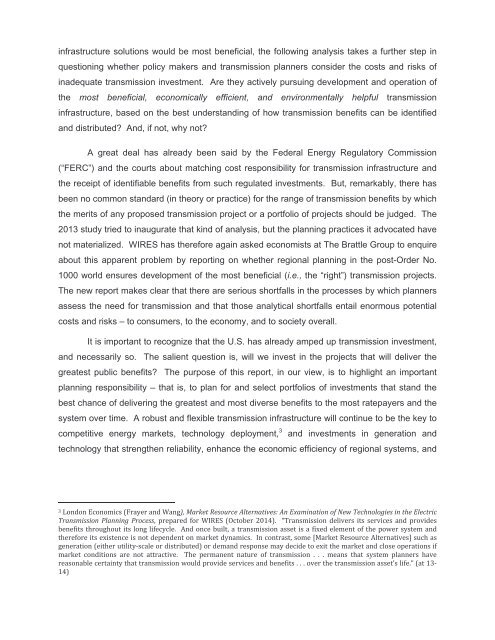THE BRATTLE GROUP
pvrbYG
pvrbYG
You also want an ePaper? Increase the reach of your titles
YUMPU automatically turns print PDFs into web optimized ePapers that Google loves.
infrastructure solutions would be most beneficial, the following analysis takes a further step in<br />
questioning whether policy makers and transmission planners consider the costs and risks of<br />
inadequate transmission investment. Are they actively pursuing development and operation of<br />
the most beneficial, economically efficient, and environmentally helpful transmission<br />
infrastructure, based on the best understanding of how transmission benefits can be identified<br />
and distributed? And, if not, why not?<br />
A great deal has already been said by the Federal Energy Regulatory Commission<br />
(“FERC”) and the courts about matching cost responsibility for transmission infrastructure and<br />
the receipt of identifiable benefits from such regulated investments. But, remarkably, there has<br />
been no common standard (in theory or practice) for the range of transmission benefits by which<br />
the merits of any proposed transmission project or a portfolio of projects should be judged. The<br />
2013 study tried to inaugurate that kind of analysis, but the planning practices it advocated have<br />
not materialized. WIRES has therefore again asked economists at The Brattle Group to enquire<br />
about this apparent problem by reporting on whether regional planning in the post-Order No.<br />
1000 world ensures development of the most beneficial (i.e., the “right”) transmission projects.<br />
The new report makes clear that there are serious shortfalls in the processes by which planners<br />
assess the need for transmission and that those analytical shortfalls entail enormous potential<br />
costs and risks – to consumers, to the economy, and to society overall.<br />
It is important to recognize that the U.S. has already amped up transmission investment,<br />
and necessarily so. The salient question is, will we invest in the projects that will deliver the<br />
greatest public benefits? The purpose of this report, in our view, is to highlight an important<br />
planning responsibility – that is, to plan for and select portfolios of investments that stand the<br />
best chance of delivering the greatest and most diverse benefits to the most ratepayers and the<br />
system over time. A robust and flexible transmission infrastructure will continue to be the key to<br />
competitive energy markets, technology deployment, 3 and investments in generation and<br />
technology that strengthen reliability, enhance the economic efficiency of regional systems, and<br />
3 London Economics (Frayer and Wang), Market Resource Alternatives: An Examination of New Technologies in the Electric<br />
Transmission Planning Process, prepared for WIRES (October 2014). “Transmission delivers its services and provides<br />
benefits throughout its long lifecycle. And once built, a transmission asset is a fixed element of the power system and<br />
therefore its existence is not dependent on market dynamics. In contrast, some [Market Resource Alternatives] such as<br />
generation (either utility‐scale or distributed) or demand response may decide to exit the market and close operations if<br />
market conditions are not attractive. The permanent nature of transmission . . . means that system planners have<br />
reasonable certainty that transmission would provide services and benefits . . . over the transmission asset’s life.” (at 13‐<br />
14)


